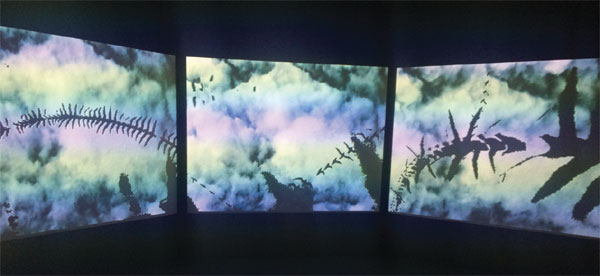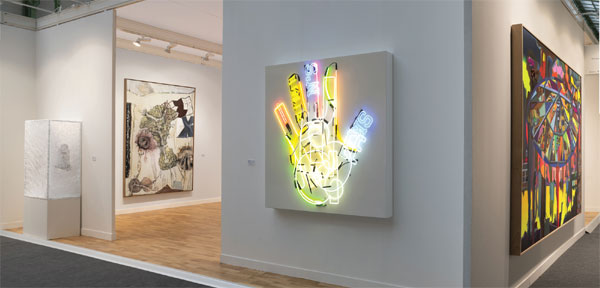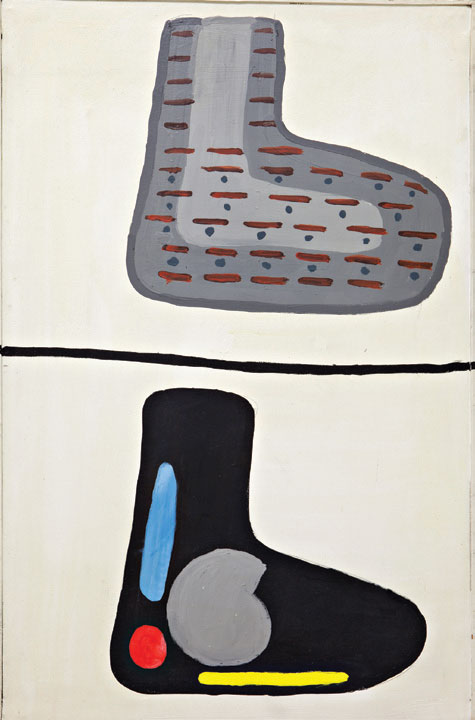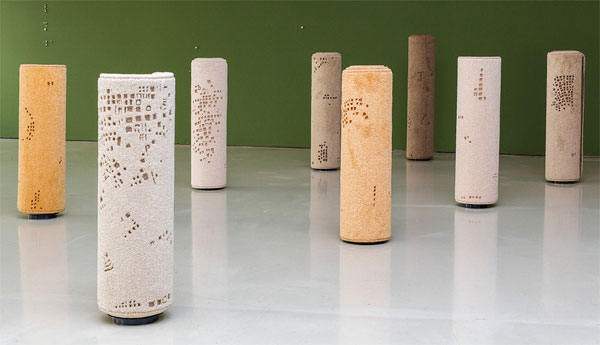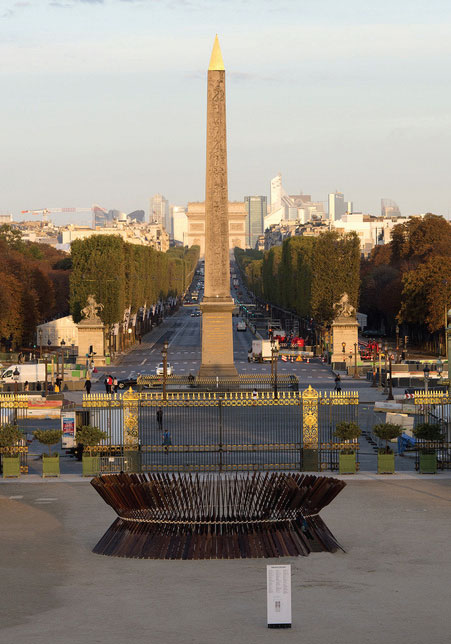|
Three-channel video installation by Steina, Berg Contemporary, Reykjavik. |

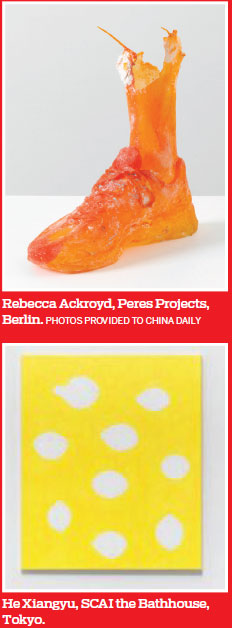
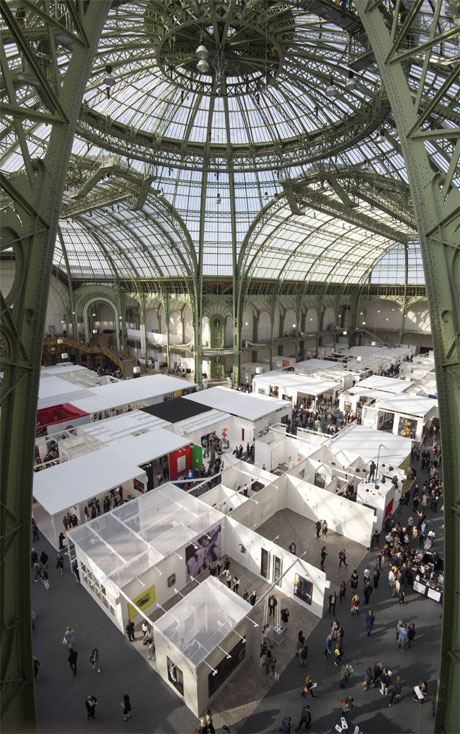
|
Art by Chiharu Shiota (extreme left) and Jitish Kallat (second from left) at Templon’s booth in FIAC 2019. |
|
Charlotte Ardon and Maxime Hourdequin of FIAC are keen to have greater participation from Chinese galleries in the fair’s future editions. |
|
Dietrich Orth, Delmes & Zander, Cologne. |
|
Hera Byktayan, Green Art Gallery, Dubai. |
Chitralekha Basu went looking for Asian presence at France’s flagship annual international art fair and stumbled on a few interesting discoveries.
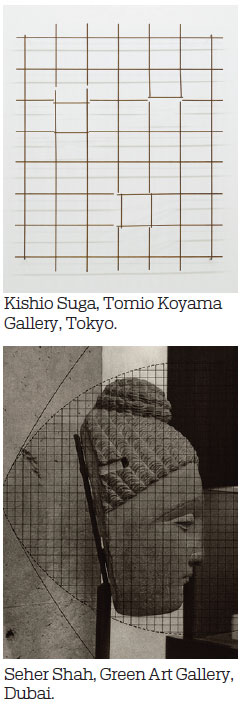
Shi Guowei was in the forefront of the minuscule group of Chinese artists under the spotlight at FIAC’s (Foire Internationale D’art Contemporain) 46th edition held last week in Paris. Born in 1977, the artist’s practice entails applying color to black and white photos by hand, as would have been done before the invention of color photography. Taking recourse to an outdated manual technique at a time when humankind’s dependence on the digital camera is practically total and universal might seem fanciful, even Luddite, but Shi’s hand-painted images draw attention to the incredible range of human vision, and indeed imagination, that the camera lens falls far short of capturing.
Mu Jinpeng, executive director of Beijing’s Magician Space art gallery, which represents Shi, points out how the artist’s sensibility resonates with the traditional Chinese literati school of landscape paintings, where “landscape is almost always esoteric, a resource deployed to conjure a spiritual state via metaphor” rather than a realistic representation of the scene. “Shi is concerned with finding means to illuminate an inner world of abstract experiences and emotions,” Mu adds.
The artist himself says he aims to combine the objective depiction of physical reality (photography) and its subjective interpretation (painting) in his works. “I have always been touched by natural landscapes, and these emotions are inseparable from my own experiences,” he says. “Seemingly ordinary sceneries can trigger my inner voices.” The colors applied are an “expression of my feelings at the time of painting,” Shi says.
Although at least nine among the 199 galleries participating in FIAC 2019 have a base in Hong Kong, there wasn’t much evidence of new Chinese art at the fair, apart from Shi’s painted photographs of nature. However, the Shanghai-born Yan Peiming who has lived in France since 1982 seems to be having a moment. An exhibition of his generic monochrome images – created by dabbing generous quantities of paint on the canvas using thick, sweeping brushstrokes – are on show at Petit Palais, alongside works by the 19th-century realist French painter Gustave Courbet. The galleries Massimo de Carlo and Thaddaeus Ropac put on some of Yan’s paintings (including a portrait of Courbet’s) at FIAC’s Grand Palais fair venue, almost as if in acknowledgement of the artist’s big show next door.
When I ask FIAC organizers about the low visibility of art from China, and indeed Asia, at the fair, Charlotte Ardon, head of collector and institutional relations, reassures me. Inviting more and more Chinese collectors to visit the fair is very much on the agenda, she says. And in order to ensure more footfalls from the East it is deemed necessary to invite more Chinese galleries to participate.
Ardon also mentions that “well-known French collectors, such as John Dodelande and Jean-Marc Decrop, are building their personal collections of Asian art,” putting to rest possible doubts about whether art from the East might have a market in Paris. “I think Asian art is getting more and more desirable,” says Ardon.
“But we do not have a quota,” Ardon’s colleague, Maxime Hourdequin, who is deputy director, exhibitor relations at FIAC, hastens to add. “What we want are the best galleries and the artists that are most interesting from everywhere in the world; the cultures they come from are not so important.”
Art from the East
Works by the South Korean pioneer of the Dansaekhwa movement, Lee Ufan, seemed a fair favorite, displayed prominently at Seoul’s Kukje and Hyundai galleries. Tomio Koyama, the director of his eponymous Tokyo-based gallery, dedicated his booth to showing works by Kishio Suga, whose art is spiritually aligned to Lee’s but of a more understated variety. While both Lee and Suga are interested in the interrelationship between natural and man-made materials and how they exist in relation to the surrounding spaces, the latter’s experimental sculptures – sometimes created in seclusion in a forest clearing with no one watching – seem to have a mystical connotation, though one which Tomio insists is “not spiritual”.
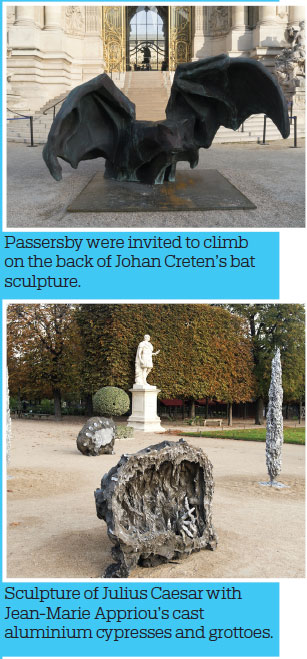
Much of Suga’s art seems to be about subtly altering bits and parts of objects from everyday life – a regular iron window grill, for instance – thus defamiliarizing the familiar. “Suga’s art is about creating a new space within the context of the known and familiar,” says Tomio.
Japan’s pop icon Yayoi Kusama was probably the most visible artist of FIAC 2019, with a giant version of her signature spotted pumpkins claiming the public square in Place Vendome most overwhelmingly.
Galerie Templon displayed a small sample of the sweeping panoramic installations by Chiharu Shiota, known for her stunning, dramatic and immersive visual narratives, often created through intense weaving of colored threads. Based out of Paris and Brussels, the gallery was also showing paintings by Jitish Kallat who is representing India at the Venice Biennale this year.
“Since 2000, we have started representing Asian artists, including many from India like Atul Dodiya, Anju Dodiya and Sudarshan Shetty. We believe there is value in confronting different cultural visions and building artistic bridges between continents,” says Anne-Claudie Coric, executive director of Galerie Templon.
The deflation of the Chinese art bubble (a phase between 2005 and 2015 which saw a large number of works of contemporary Chinese art inspire wildly speculative bidding), has helped the better artists find a more stable market and a steady supply of informed clients, whether or not their works are prominently displayed in the art fairs in Europe, says Coric. “Now that galleries show their pieces in multiple art fairs all year round, there is a higher circulation of Asian artists in general. They are seen for their inner aesthetic qualities, not only their nationality,” she adds.
Women power
FIAC 2019 saw a bunch of strikingly powerful new art created by women. Flying the flag for the Istanbul-based artist Hera Byktayan and New Delhi’s Seher Shah were Yasmin Atassi and Raya Kassisieh of Green Art Gallery, Dubai. Byktayan’s rolled-up carpets made to stand vertically, like a series of pillars bearing the dents of time, are meant as an ode to the lost Turkish city of Pergamon. Shah’s polymer photogravure prints of the Gandhara sculptures (a fusion of Classical Greek and Buddhist art traditions developed in Central Asia roughly 2,000 years ago) housed in Chandigarh’s government museum and art gallery offer a critical commentary on their complicated legacy, especially in the context of growing nationalist sentiments in India.
Rebecca Ackroyd’s reconstructions of an imaginary plane crash – showing truncated body parts still tied to the remains of a seat – stood out for their flaming red color. The combination of steel, epoxy, resin, polyurethane resin, plaster and paraffin wax had been used masterfully, making the depiction of what is macabre in real life strangely attractive in art. “Rebecca is interested in the idea of identity and time: What we have here in the present and the traces of humanity we leave behind,” says Margherita Rossi of Berlin-based Peres Projects, the gallery representing Ackroyd. “Red is her favorite color, and the use of resin, very light and incredibly fragile, makes her figures monumental, volcanic, fiery – symbolic of the powerful identity that we all carry.”
Works by video art pioneers Steina and Woody Vasulka, founders of New York’s influential artists’ collective The Kitchen, were on show at Berg Contemporary. A three-channel video installation titled Orka (meaning life force) showed waves crashing forcefully against the shore, superimposed with digitally-altered images, giving a surreal spin to a familiar, natural phenomenon.
“These are images of Icelandic shores processed in a way to make them look like lunar landscapes,” says Berg Contemporary’s Kristin Scheving. “Steina being a violin player, the images reflect the contrapuntal movements of music.”
Looking at the charmingly quaint images by Dietrich Orth, it’s difficult to digest that these were created by a tortured soul, suffering from paroxysms of schizophrenia.
“His works are interesting because they are hard to categorize. They are in between outsider art, painting and conceptual art,” says Susanne Zander, of the Cologne-based Delmes & Zander. With co-owner Nicole Delmes, Zander went about putting together a substantial body of work by Orth who seemed to have slipped from the collectors’ radar since the Nineties when he was unable to paint any more as a result of excessive medication.
“There was a time when people thought outsider art is necessarily of the rough, stark kind. But Orth’s paintings helped change that notion, which makes him historically important,” says Zander. “Looking at his paintings allows one to feel a comfortable heaviness.”
She is happy to have sold most of the pieces the gallery had brought to FIAC. “If after a 30-year gap, his works still resonate, it shows they are important. It also shows the desirability of art has nothing to do with being fashionable.”
Interesting times
The opening of FIAC’s Hors Les Murs section (see sidebar) in Jardin des Tuileries was punctuated by the sound of firecrackers going off outside the compound. Protesters in high-visibility vests winding their way through the “ephemeral village of architectural projects” that has sprung up on Place de la Concorde, were registering their presence as they went.
I asked Ardon and Hourdequin about the concerns they might have about hosting an international art fair, attended by a galaxy of artists and well-known collectors from all over the world, in a time of civil unrest.
The duo emphatically stated that protests on the streets of Paris did not put off overseas visitors from traveling to the city.
The presence of protesters in the background is a reminder of the present realities, and art is not dissociated from real life, says Hourdequin. “What we try to do is find a balance between disparate elements – the marketing of art and the use of art as a tool for education, for example.”
“Life does not stop because of security issues, so I don’t see why there shouldn’t be an art market at the time of mass protests,” says Ardon.
Indeed, even as the five-day carnival celebrating art and the people who make them drew to a close, the tide of visitors converging under the glass vault at Grand Palais, held up by the light iron framing with intricate floral designs, seemed unabated.
Contact the writer at basu@chinadailyhk.com
|
Moataz Nasr’s Sun Boat is a tribute to migrants from history and the present. |
|
Yayoi Kusama’s giant illuminated pumpkin is now a prime attraction of Le Place Vendome. |
(HK Edition 10/25/2019 page8)

